Saving Rugs: First Response in Home Floods
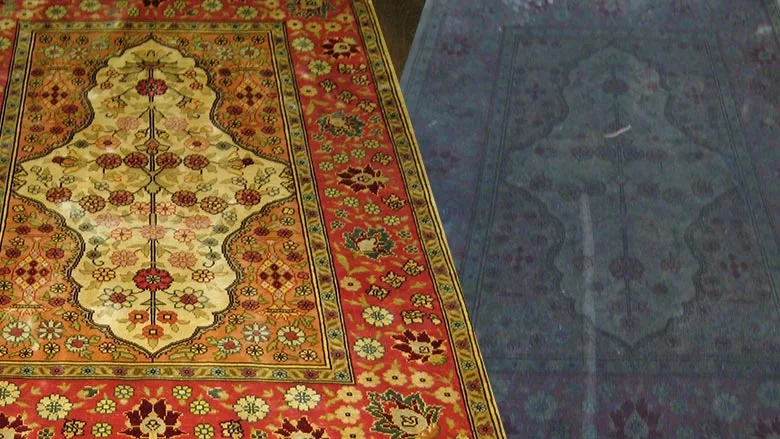
Turkish Hereke handwoven silk rug saved from a fire. Corrective work by Blatchford’s Rug Cleaning (San Diego).
In the middle of a disaster, rugs can be easily overlooked.
If there is not a response team member with solid rug inspection skills, it may be difficult to know which rugs are easily and affordably replaced versus ones that are not. It can also be tough to know which rugs can be saved or not without someone trained in fibers, dyes, and rug identification helping with the textile triage.
The higher quality (and higher value) rugs can often survive a flood (or fire) with a quick, proper pack-out. For an insurance adjuster, and a policyholder, being able to save quality rugs instead of replacing them can sometimes be one of the few bright spots of a loss.
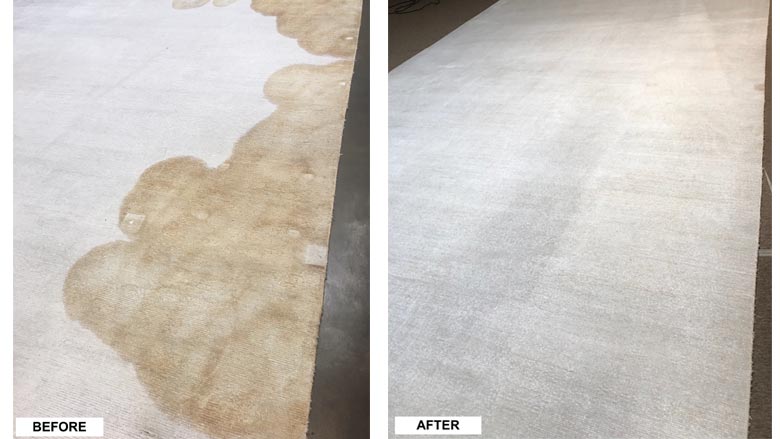
Nepalese handwoven silk and hemp rug saved from a flood. Corrective work by Blatchford’s Rug Cleaning (San Diego).
Knowing which rugs to focus on, and which ones to set aside, can help you prioritize your efforts in an emergency response.
Here are some steps to help save the rugs worth saving:
- Ask homeowners about their rugs. People who own higher quality contemporary or antique rugs know they have rugs worth saving. If more than one rug is affected in the loss, ask if there are ones more important than others, and handle the rugs in that order. Feeling heard and seeing action to save something important to them helps build rapport that can help a restorer later on in their project.
- Focus efforts on the woven rugs first. If there is no homeowner to speak with, look at the back side of the rugs to determine which rugs are woven versus tufted. Woven rugs you can clearly see the design and fibers on the back side of the rug. Tufted production will have a backing added. This is a quick way to identify a quality difference in rugs in an emergency.

Left: Handwoven wool rug, corner flipped over. Design is clearly mirrored on the back. Middle: Machine woven wool rug, corner flipped over. Design is clearly mirrored on the back. Right: Tufted wool rug, corner flipped over. Backing added no design visible on the back.
- Triage with a rug expert. Reach out to the rug expert in your network. Photos with one corner of a rug flipped over will allow a rug expert to evaluate which rugs are more likely to be saved. In my region, several times a week we handle textile triage by text with photos to assist restoration responders in knowing which rugs to save, which ones to set aside, and what actions to take immediately to mitigate rug damage.
- Dry out as soon as possible. Extract carefully. If you do not have a rug wash division to immediately wash these contents, then drying out the rugs is paramount to halting the damage and slowing down mildew issues. Extraction tools can sometimes be too aggressive on wet wools and silks causing fiber damage. Extract from the back side if concerned.
- Protect damp rugs in transport. Cover damp rugs in water absorbent pads/mats, blankets, or towels, and roll up. This removes moisture (along with released dyes) away from the rug during transport minimizing dye migration damage. This also limits dye transfer between the back and front sides which can extremely difficult to correct. Common pack-out damage is caused by stacking damp rugs on top of one another without a barrier in between them. When stacking damp rugs even simple plastic sheeting between rugs can minimize damage if better absorbent options are not available.
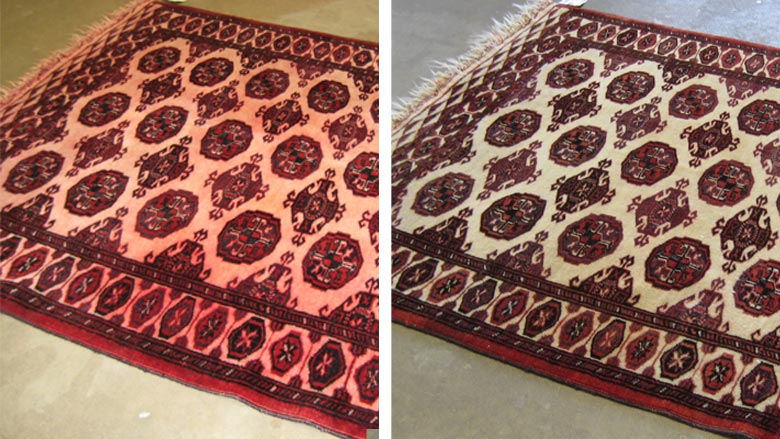
Turkoman handwoven wool rug saved from a flood. Corrective work by Blatchford’s Rug Cleaning (San Diego).
- Thoroughly treat and clean based on the contamination type and rug condition. With woven rugs the interior foundation fibers are predominantly cotton, as well as other natural fibers. Surface-only cleaning is not an option for flood-affected rugs. The interior fibers must be treated with sanitizing solutions appropriate for the fibers involved, and a wash appropriate for the category of water involved and appropriate for the rug type. Even machine woven synthetic rugs often have jute or cotton foundation fibers, which also may require a sanitizing solution application prior to cleaning.
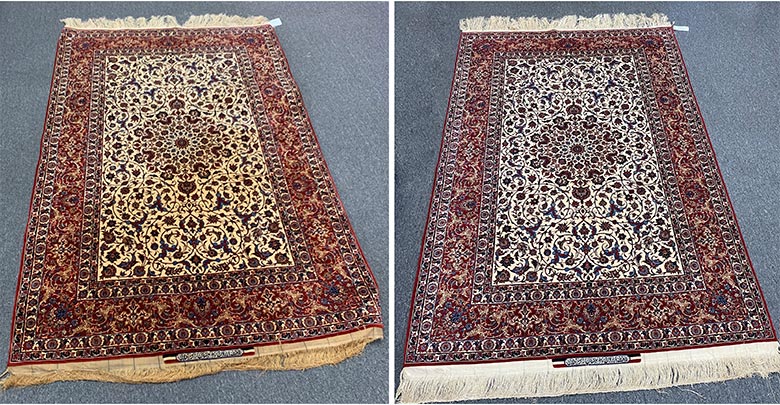
Isfahan handwoven wool and silk rug saved from a flood. Photos by Lisa Wagner, corrective work by Robert Mann Rugs (Denver).
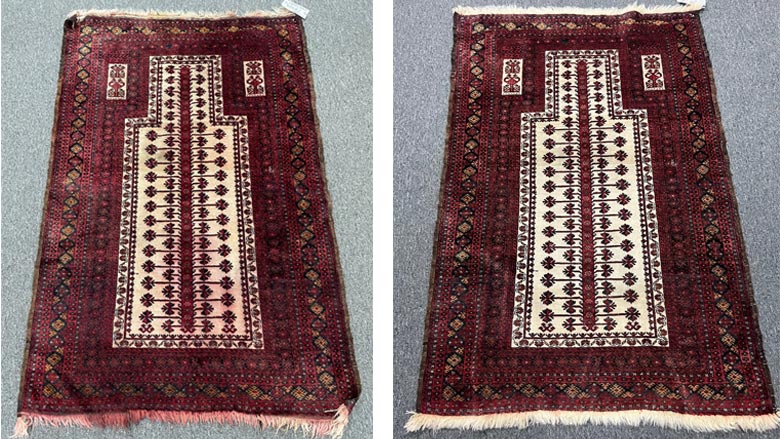
Baluchi handwoven wool rug saved from a flood. Photos by Lisa Wagner, corrective work by Serafian’s Oriental Rugs (Albuquerque).
- Seek out specialized rug restoration options for “irreplaceable” rugs. It may be possible to improve the look of a water-damaged rug through corrective chemical work or to improve it through other options such as reweaving, fringe replacement, or dyeing. Though this may not return a rug to its pre-loss condition, it may improve the condition enough for the owner to continue to enjoy a favorite textile if replacing it is not a feasible (or affordable) option.
Many high quality rugs can be saved from floods with a quick response and proper cleaning. For rug owners this can sometimes be the one bit of good news from their home disaster experience.
Rugs Involved in Fire Losses
One characteristic of wool and silk fibers is that they self-extinguish. If you are an expert at fiber identification with the “burn test,” then you know this already. What this means in a fire loss is that sometimes in a situation where most of the home’s contents are damaged beyond saving, the higher quality wool and silk rugs may not be.
In situations where the damage is heavy soot and odor, some rugs can be brought back to life. As with water damage losses, quick action is critical as the corrosiveness and acidity of the soot can cause dye and fiber damage if left untouched for too long.

Turkish Hereke handwoven silk rug saved from a fire. Corrective work by Blatchford’s Rug Cleaning (San Diego).
Looking for a reprint of this article?
From high-res PDFs to custom plaques, order your copy today!







